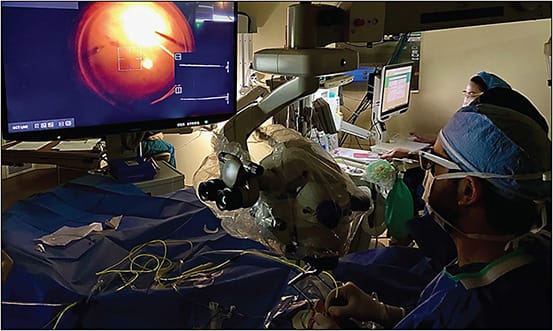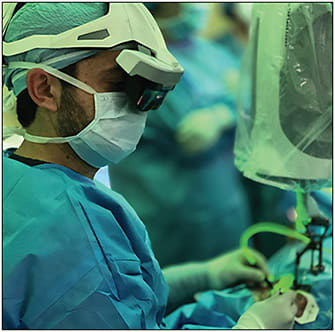Related
The evolution of retinal surgery has chalked up important milestones since 2015, with the introduction of technology that enables traditional ocular microscopes to be used for what is colloquially referred to as “heads-up surgery.” More recently, the surgical genre took a leap forward with equipment that combines a high-definition digital exoscope with augmented reality technology for an immersive next-generation heads-up experience. While neither iteration of the heads-up paradigm is widespread as of yet, they are common at academic institutions, such as my clinic at Bascom Palmer Eye Institute, in Miami, where in addition to being a staple in my surgical routine, they are integral to the education of tomorrow’s retinal surgeons.
| HEADS-UP SYSTEM | DESCRIPTION |
| Artevo 800 (Zeiss) | The stereoscopic 3D images of the Artevo 800 are viewed on a 55-inch, 4K resolution monitor that provides outstanding depth of field and high-resolution images with natural colors. Equipped with intraoperative OCT, the Zeiss Artevo 800 streamlines surgical decision-making and helps to ensure correct tissue placement during surgical procedures, increasing safety and optimizing outcomes. |
| Beyeonics One (BVI/Beyeonics Vision) | The fully digital Beyeonics One augmented reality headset comprises 3D ultrahigh-resolution cameras, stereoscopic illumination, and removable mount for a noncontact wide-angle lens for posterior segment surgeries. The platform comprises a powerful computing core supporting 3 headsets, an internal touchscreen, and an external 4K monitor all supporting zero perceived video latency. |
| Ngenuity 3D (Alcon) | The Ngenuity 3D Visualization System comprises a high-definition 3D digital camera, a high-speed graphics processing unit computer that processes and optimizes stereoscopic images, a 55-inch immersive 3D display that renders real-time images with 4K light-emitting diode (OLED) ultrahigh-definition pixel resolution technology; and passive, circularly polarized 3D glasses that provide the surgeon with a 3D view of the retinal field. |
HEADS-UP SYSTEMS
Traditional ocular microscopes use conventional glass optics and provide image magnification and illumination to help visualize the surgical field. Retinal surgeons relied on variations of these tools for decades, and these tools represent the foundation from which all current and future retinal microscopy developments are based. The earliest generation of heads-up systems include Ngenuity 3D (Alcon), and Artevo 800 (Zeiss) (Figures 1 and 2). With both of these systems, images are captured via analog optics, displayed on a large external monitor, and viewed via 3D glasses. This eliminates the need to look down into a microscope to see the surgical field. The ergonomic benefits are obvious — and invaluable — given the duration of intricate retinal procedures. A newer generation of heads-up surgery has emerged in the form of the Beyeonics One ophthalmic exoscope (BVI/Beyeonics Vision), a platform that relies exclusively on digital oculars and is the first retinal imaging system to utilize an augmented reality (AR) headset (Figure 3). The headset is controlled by the surgeon’s head-gesture commands and a footswitch that can be used to change the view from the actual surgical field to an interior microscopic view of the procedure, overlaid with data from a patient’s health record, preoperative diagnostic tests, and surgical device readings.



HEADS-UP BENEFITS
All 3 heads-up systems share several key benefits: lower illumination levels, a reduced risk of phototoxicity; enhanced depth of field and amplified stereopsis, which enables a wider view; reduced glare of instruments and even image brightness; the ability to share the surgical view with everyone in the room, which helps with education; improved ergonomics because surgeons can maintain a heads-up position facilitating a less rigid and more comfortable posture; and reduced asthenopia because these systems do not require lengthy use of near vision (Sidebar). These capabilities are among the reasons that the Ngenuity and Artevo systems have been integral to my surgical routine for the past several years and will continue to be.
The Beyeonics One exoscope is not yet available for purchase in the United States; however, I was recently afforded the opportunity to use the platform on a trial basis. I performed approximately 15 consecutive cases. Among the things I learned from this experience is that the fully digitized system allows for images to be manipulated to enhance visibility. For instance, if there is media opacity that makes visualization difficult, manipulating the images post acquisition becomes possible because the images are acquired via digital oculars. At first blush the AR headset appears a bit futuristic, but being able to use my head motions to zoom in and to focus ultimately felt natural and intuitive. During the trial period, I used the exoscope platform on everything from simple cases to complex cases and the element that felt most natural was the ability to pan around the eye by moving my head. It felt instinctive, for instance, to decide that I want to see what’s going on in the temporal retina and be able to simply move my head and look in that direction and then have that come into the center of my image. The AR headset was not a barrier to utilization. I believe surgeons will embrace this technology once it is widely available. The transition can be seamless from either a traditional microscope or a first-generation heads-up microscope to the next-generation heads-up exoscope.
ERGONOMICS AND EDUCATION
After many years of being hunched over a microscope throughout hours-long surgical procedures, the ability to maintain a heads-up position with all the systems mentioned in this article is a boon, but when the AR headset is factored into the equation the benefits multiply. I could move my head in any direction without losing sight of the surgical field, and this allowed greater freedom to find the most ergonomically comfortable sitting position. Visualizing the surgical field through the AR headset removes the problem of vertical spine tethering typical of conventional microscopy, or angular neck tethering that is a shortcoming of external screen–based heads-up microscopy systems. The AR headset is also lightweight and does not inhibit freedom of movement.
The AR headset makes surgery an immersive experience. As an educator, this ability to invite my students into the metaverse to view my surgical technique via 3D imagery is priceless. I suspect this technology will revolutionize surgical education. If a student or surgeon anywhere in the world can wear an AR headset and experience in real time the procedure that I or other surgical educators are performing, the possibilities are endless. I find the potential teaching applications of this technology to be among its most exciting aspects.
CONCLUSION
I’ve used heads-up technology exclusively for several years. I’ve had ample experience with both the Ngenuity and Artevo systems. I have had — and continue to enjoy — positive experiences with both of them. The Beyeonics One builds on the benefits of the heads-up paradigm. The potential future applications of AR in retinal surgery are promising for interconnectivity within the clinic and beyond, with respect to education and interacting with surgeons in remote and/or underserved areas. RP








